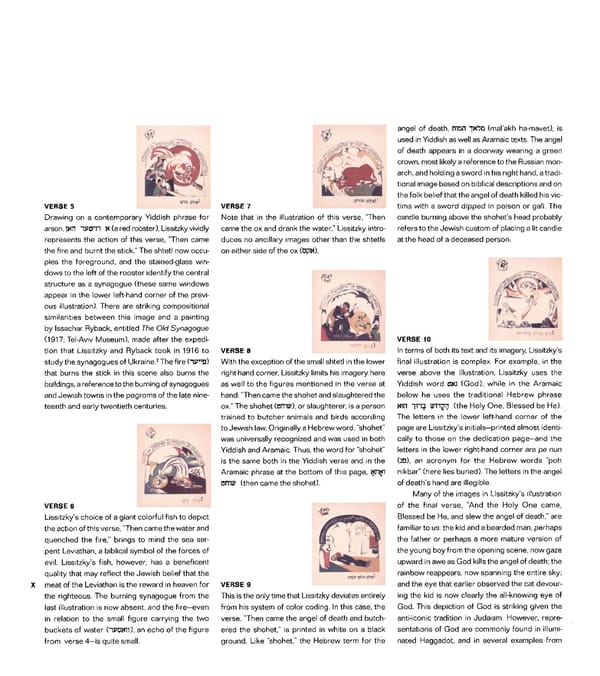angel of death, TIIDn ^*?D (mal'akh hamavet), is used in Yiddish as well as Aramaic texts. The angel of death appears in a doorway wearing a green crown, most likely a reference to the Russian mon arch, and holding a sword in his right hand, a tradi tional image based on biblical descriptions and on the folk belief that the angel of death killed his vic VERSE 5 VERSE 7 tims with a sword dipped in poison or gall. The Drawing on a contemporary Yiddish phrase for Note that in the illustration of this verse, "Then candle burning above the shohet's head probably arson, |XH "l^OTI N (a red rooster), Lissitzky vividly came the ox and drank the water," Lissitzky intro refers to the Jewish custom of placing a lit candle represents the action of this verse, "Then came duces no ancillary images other than the shtetls at the head of a deceased person. the fire and burnt the stick." The shtetl now occu on either side of the ox (OpN). pies the foreground, and the stainedglass win dows to the left of the rooster identify the central structure as a synagogue (these same windows appear in the lower lefthand corner of the previ ous illustration). There are striking compositional similarities between this image and a painting by Issachar Ryback, entitled The Old Synagogue (1917; TelAviv Museum), made after the expedi VERSE 10 tion that Lissitzky and Ryback took in 1916 to VERSE 8 In terms of both its text and its imagery, Lissitzky's 2 study the synagogues of Ukraine. The fire ("1P"D) With the exception of the small shtetl in the lower final illustration is complex. For example, in the that burns the stick in this scene also burns the righthand corner, Lissitzky limits his imagery here verse above the illustration, Lissitzky uses the buildings, a reference to the burning of synagogues as well to the figures mentioned in the verse at Yiddish word 0*O (God), while in the Aramaic and Jewish towns in the pogroms of the late nine hand: "Then came the shohet and slaughtered the below he uses the traditional Hebrew phrase teenth and early twentieth centuries. ox." The shohet (fllTO), or slaughterer, is a person «m ira wnjm (the Holy One, Blessed be He). trained to butcher animals and birds according The letters in the lower lefthand corner of the to Jewish law. Originally a Hebrew word, "shohet" page are Lissitzky's initials—printed almost identi was universally recognized and was used in both cally to those on the dedication page—and the Yiddish and Aramaic. Thus, the word for "shohet" letters in the lower righthand corner are pe nun is the same both in the Yiddish verse and in the 02), an acronym for the Hebrew words "poh Aramaic phrase at the bottom of this page, NJ1N1 nikbar" (here lies buried). The letters in the angel anittf (then came the shohet). of death's hand are illegible. Many of the images in Lissitzky's illustration VERSE 6 of the final verse, "And the Holy One came, Lissitzky's choice of a giant colorful fish to depict Blessed be He, and slew the angel of death," are the action of this verse, "Then came the water and familiar to us: the kid and a bearded man, perhaps quenched the fire," brings to mind the sea ser the father or perhaps a more mature version of pent Leviathan, a biblical symbol of the forces of the young boy from the opening scene, now gaze evil. Lissitzky's fish, however, has a beneficent upward in awe as God kills the angel of death; the quality that may reflect the Jewish belief that the rainbow reappears, now spanning the entire sky; X meat of the Leviathan is the reward in heaven for VERSE 9 and the eye that earlier observed the cat devour the righteous. The burning synagogue from the This is the only time that Lissitzky deviates entirely ing the kid is now clearly the allknowing eye of last illustration is now absent, and the fire—even from his system of color coding. In this case, the God. This depiction of God is striking given the in relation to the small figure carrying the two verse, "Then came the angel of death and butch antiiconic tradition in Judaism. However, repre buckets of water ("120*01), an echo of the figure ered the shohet," is printed in white on a black sentations of God are commonly found in illumi from verse 4—is quite small. ground. Like "shohet," the Hebrew term for the nated Haggadot, and in several examples from
 Had Gadya The Only Kid: Lissitzky 1919 Page 11 Page 13
Had Gadya The Only Kid: Lissitzky 1919 Page 11 Page 13